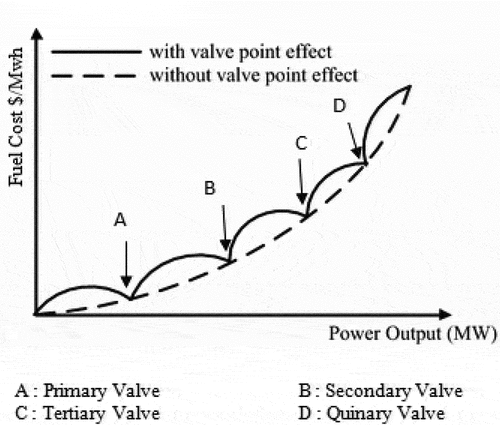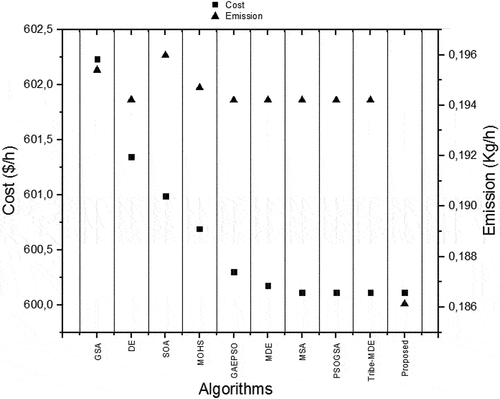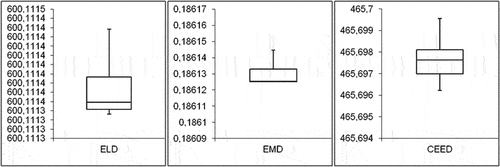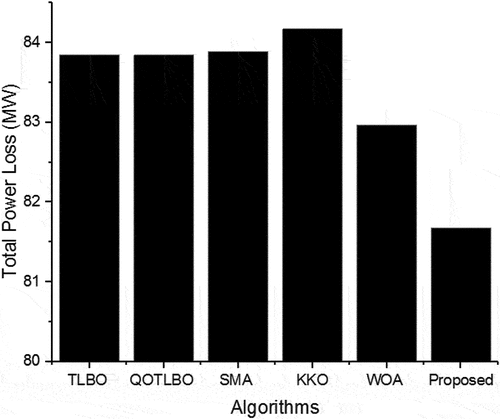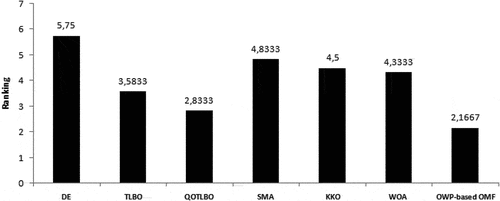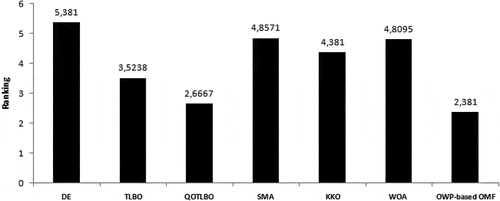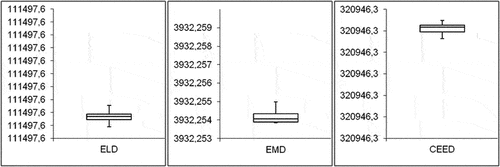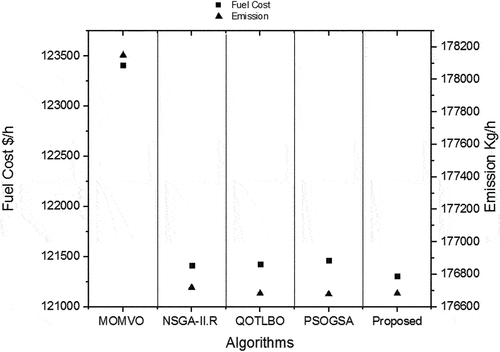 ?Mathematical formulae have been encoded as MathML and are displayed in this HTML version using MathJax in order to improve their display. Uncheck the box to turn MathJax off. This feature requires Javascript. Click on a formula to zoom.
?Mathematical formulae have been encoded as MathML and are displayed in this HTML version using MathJax in order to improve their display. Uncheck the box to turn MathJax off. This feature requires Javascript. Click on a formula to zoom.ABSTRACT
In the present paper, the Optimization Without Penalty-based Optimization by Morphological Filter algorithm (OWP-based OMF) has been proposed to find the optimal solution for the Combined Economic and Emission Dispatch (CEED) problem. The objective function of the CEED problem is to minimize fuel cost and emission simultaneously while satisfying the load demand, equality and inequality constraints. The evaluation of OWP-based OMF performances is carried out on three test systems with 6, 10 and 40 generating units, with different constraints and various costs. The present paper shows that OWP-based OMF gives an accurate and effective solution of the CEED problem and outperforms the other tested algorithms.
Introduction
The electrical power system is planned and operated such that it could be reliable, economical, secure and to meet the environmental constraints. Economic Dispatch (ED) is the process of allocating the required load between the available generation units with minimal operational cost (Abido Citation2003). Economic Dispatch (ED) problem has become a crucial task in the operation and planning of power system (Chakrabarti and Halder Citation2010). It is very complex to solve because of a nonlinear objective function and a large number of constraints. Fossil-fuel-based power stations generate two-thirds of the electric power (Rex and Marsaline Beno Citation2017). The electricity produced from fossil fuel generator releases numerous noxious wastes. These comprise of carbon dioxide (), sulfur dioxide (
), nitrogen oxide (
) and some particles, which in turn pollutes the atmosphere. These harmful environmental pollutants emitted from fossil-fuel power plants can be reduced by appropriately distributing the load among the available generators. But this will result to an increase in operating costs of power plants. Therefore, a solution that balances emissions and fuel costs needs to be determined. This can be solved through Combined Economic and Emission Dispatch (CEED) problem. The main target of combined economic and emission dispatch is to minimize both fuel cost and emission simultaneously while satisfying the load demand, equality and inequality constraints.
Mostly, the CEED has been defined as a conflicting bi-objective optimization problem. Thus, the resolution of this kind of problem leads to a set of optimal solutions, called non-dominated solutions or Pareto solutions, instead of a single solution (Guesmi et al. Citation2020). From a mathematical viewpoint, approaches applied for solving CEED can be classifled into three categories. In the flrst category, fuel cost and emissions have been combined in a single-objective function by the linear weighted sum or normalizing fuel cost and emissions by using price penalty factors (Bhattacharjee, Bhattacharya, and Halder nee Dey Citation2014; Jiang, Ji, and Wang Citation2015a; Pazheri et al. Citation2015). The second category also converts the CEED into a single-objective problem but by incorporating the emissions in the system constraints (Jevtic et al. Citation2017; Palit and Chakraborty Citation2019). The third category involves both functions simultaneously where the Pareto set is generated in one run of the opted optimization algorithm (Morsali et al. Citation2014).
Researchers have been done studies to solve the CEED problem using classical and metaheuristic methods. The conventional mathematical optimization methods such as gradient method (Dodu et al. Citation1972), lambda iteration method(Aravindhababu and Nayar Citation2002), linear programming (Parikh and Chattopadhyay Citation1996), Lagrangian multiplier method (El-Keib, Ma, and Hart Citation1994), and classical technique based on coordination equations (Nanda Citation1994) have been implemented to solve CEED problem. However, most of them have difficulties in solving ED problems due to nonlinearity and nonconvexity fuel cost and emission characteristics. The conventional optimization methods prematurely converge to the local optimal solution and are sensitive to the initial starting value. Moreover, these methods are not able to find a solution with a significant computational time for CEED problem (Benasla, Belmadani, and Rahli Citation2014).
Metaheuristic optimization algorithms play a decisive role in alleviating the problems of traditional methods. Genetic algorithm (GA)(Hamid et al. Citation2005), simulated annealing (SA) (Wong and Fung Citation1993), particle swarm optimization (PSO) (Hamid et al. Citation2005), artificial bee colony (ABC) (Bhongade and Agarwal Citation2016), biogeography-based optimization (BBO) (Bhattacharya and Chattopadhyay Citation2010), flower pollination algorithm (FPA) (Abdelaziz, Ali, and Abd Elazim Citation2016), backtracking search algorithm (BSA) (Bhattacharjee, Bhattacharya, and Halder nee Dey Citation2015), lightning flash algorithm (LFA) (Kheshti et al. Citation2018) and real coded chemical reaction algorithm (RCCRO) (Bhattacharjee, Bhattacharya, and Halder nee Dey Citation2014) are the most popular metaheuristics. Certainly, different meta-heuristic algorithms have been employed to solve the CEED problem. Among the hybrid algorithms utilized in solving the CEED problem, we mention, (i) hybrids which combine two single-objective algorithms such as the artificial bee colony (ABC) algorithm is combined with simulated annealing (SA) in (Sundaram, Saranya, and Sangeetha Citation2013), two different metaheuristic algorithms PSO and firefiy algorithm is combined in (Arunachalam, AgnesBhomila, and Ramesh Babu Citation2014), hybrid firefiy and bat algorithm in (Gherbi, Bouzeboudja, and Gherbi Citation2016) and hybrid PSO-GSA in (Radosavljević Citation2016). (ii) Hybrids which combine two multi-objective algorithms such as multi-objective GA-PSO in (Agarwal and Nanavati Citation2016), hybrid NSGAII-MOPSO in (Sundaram and Erdogmus Citation2017) and hybrid MOPSO-Differential Evolution (DE) in (Gong, Zhang, and Qi Citation2010). Although these heuristic algorithms generate the best solution to the combined economic and emission dispatch problem, none of them guarantees the best optimal solution.
This paper presents the Optimization Without Penalty-based Optimization by Morphological Filter algorithm (OWP-based OMF)(Zaoui and Belmadani Citation2021) for solving Combined economic and emission dispatch problem. OWP-based OMF is a recent stochastic optimization algorithm inspired by morphological transformations. The algorithm is used in order to successfully solve different engineering optimization problems. It is clear from the literature survey that the application of OWP-based OMF to solve ELD, ECD and CEED problems has not been discussed yet. This encourages us to adopt OWP-based OMF to deal with these problems. The performance of proposed algorithm is evaluated on different test systems, which are 6 generating units, 10 generating units and 40 generating units. The results are compared with the other algorithms in the literature. The experimental result shows that the proposed algorithm dominates other heuristic algorithms. The remainder of this paper is organized as follows: Section 2 provides a brief description and mathematical formulation of ELD, ECD and CEED problems. In section 3, the concept of OWP-based OMF is presented. Section 4 shows the result on six, ten and forty unit test systems. The last section specifies the conclusion part.
Formulation of CEED problem
The CEED problem is to minimize the fuel cost and emissions as two competing objective functions at the same time with various equality and inequality constraints satisfaction. The problem can be formulated as follows.
Economic load dispatch (ELD)
The objective function of the ELD problem is minimizing the fuel cost for a specifled load demand while satisfying various system and unit constraints. Fuel costs are usually expressed as a quadratic function of output power (Wood, Wollenberg, and Sheblé Citation1996), as shown in Equationequation 1(1)
(1) .
where FC is the total fuel cost of generations ,
,
and
are the fuel cost coefflcients of the
unit,
is the output power of the
unit, and
is the number of generation units. In practice valve point effect is considered as the fuel cost function of the generator. The sharp increase in losses due to the wire drawing effects which occur as each steam admission valve starts to open leads to the nonlinear rippled input output curve (Walters and Sheble Citation1993) as shown in . The obtained cost function based on the rippled curve is more accurate modeling. Thus, the fuel cost function of each fossil fuel generator is given as the sum of a quadratic and a sinusoidal function (Senthil and Manikandan Citation2010).
where FC is the total fuel cost considering valve-point loadings,
and
are the fuel cost coefflcients of the
unit that refect the valve-point effect.
Emission dispatch (EMD)
Fossil fuel-fired power plants emit sulfur oxides, nitrogen oxides, and carbon oxides. The total emission of these pollutants can be also expressed as the sum of a quadratic function and an exponential function. This function is illustrated as follows:
where E is the total amount of emissions ,
,
,
,
and
are the emission coefflcients of the
unit.
Constraints
During the minimization process, some equality and inequality constraints must be satisfied. In this process, an equality constraint is called a power balance and an inequality constraint is called a generation capacity constraint.
System power balance constraint
The minimization is performed subject to the equality constraint that the total electrical power generation should meet load demand and total transmission loss:
where is the total load demand, and
is the total power transmission losses which can be expressed as a function of the units output power and B-loss coefflcients. The simplest form of loss equation is Kron’s formula as presented in Equationequation 5
(5)
(5) .
where is the
element of the loss coefflcients square matrix,
is the
element of the loss coefflcients vector and
is the loss coefflcient constant.
Power output constraints
According to this constraint, each generator should produce power within a minimum and maximum limit.
Combined economic emission dispatch (CEED)
The CEED problem can be formulated by combining two independent objectives, which are emission and fuel cost using a price penalty factor. In this way, the bi-objective CEED problem is expressed in a single-objective form. To solve the CEED problem, this form is intended to minimize while satisfying the constraints expressed above. The single-objective CEED problem is formulated as follows:
where is the total operating cost in
,
is the weighting factor that can be varied between 0 and 1 and
is the price penalty factor in
or
. The various types of penalty factors are formulated in (Dey, Basak, and Bhattacharyya Citation2021; Dey, Bhattacharyya, and Fausto Pedro García Citation2021; Dey et al. Citation2020; Dey, Roy, and Bhattacharyya Citation2018). By the following steps
for a specified load demand can be calculated:
Table 1. Penalty factor calculation
Step 1: Calculate for each unit according to 8:
Step 2: Sort values in an ascending order.
Step 3: Add maximum output power of each unit one at a time starting from the unit with smallest until
.
Step 4: associated with the last unit is
for the given load demand (Benasla, Belmadani, and Rahli Citation2014).
The proposed algorithm
The Optimization Without Penalty-based Optimization by Morphological Filter algorithm (OWP-based OMF) is a new heuristic optimization algorithm described by (Zaoui and Belmadani Citation2021). This algorithm, which is based on the erosion process, it consists to flnd the minimum combination of pixel values in the neighborhood of morphological filter. OWP-based OMF has been adopted in this paper to solve ELD, EMD and CEED problems. The Optimization by Morphological Filters (OMF) algorithm is a stochastic optimization approach inspired by transformations of mathematical morphology where several morphological filters are launched in parallel and each of them returns a minimum found in its neighborhood. The general principle of the OMF algorithm is to compare the solution represented by the center of the filter with those represented by its neighbors. If one of the neighbors gives a better solution, then the center of this filter is moved to that neighbor. Otherwise, the size of the filter previously fixed decreases to visit a closer neighbor. The criterion for stopping this algorithm is visiting the search space until the size of the filter is negligible, close to zero. The algorithm starts with random generation, all variables generated must be ranged in the interval [0,R]. This is assured by normalization process (Postaire and Vasseur Citation1981) defined as follows:
The number of filters and the number of neighbors are fixed at the initialization step. During the search process, if a better neighbor is found, the center of the filter is moved on it. Otherwise, the size of the filter is reduced in order to check a closer neighborhood. The algorithm stops when the sizes of all the filters become too small . The reduction is ensured by the following formula:
where is the range of search space,
denotes the number of reductions of the size of the actual filter and
is a constant which is fixed in our case at
. In morphology, erosion decreases the outline of objects. This function is adapted by formula 9 to decrease the filter size.
The coordinate of each neighbor is calculated by taking one of the following options: do not change, shift left, shift right or take a random position. The first three possibilities are realized with the following equation:
where denotes the size of the filter in progress and
is a parameter randomly chosen from the set
. To explore unvisited regions of the search space and to diversify the search, the
coordinate can be calculated using to the following formula:
A constraint handling approach without penalty, called OWP (Optimization Without Penalty), is introduced for solving constrained optimization problems in order to force the respect of the constraints. Firstly, the approach consists in addition of a loop; call it intensification loop; which allows having more choice of neighbors and more chance of having feasible solutions. It intensifies the local search of the neighbors of each filter. Secondly, we ensure that the next criteria will be always enforced to compare two solutions at a time: a) Any feasible solution is preferred over an infeasible solution, b) Between two feasible solutions, the solution having the best value of the objective function is preferred, c) Between two infeasible solutions, the solution with a lower violation value is preferred. This violation can be evaluated in different ways:
1) The summation:
2) The average:
3) The number of constraints not respected:
such as: is the degree of violation,
is the number of constraints not respected, the function
measures the violation of the
constraint.
The degree of violation qualifies the solution: If then the solution is considered as infeasible; if
the solution is considered feasible. Under no circumstances, the violation degree is added to the objective function of the infeasible solution. So, the infeasible solution is not penalized and it is not rejected. Interested readers may refer (Zaoui and Belmadani Citation2021), which contains the detail of the OWP-based OMF Algorithm.
Case studies and results
To assess the efficiency of the OWP-based OMF, it has been applied to solve ELD, EMD and CEED problems by considering (03) three various test systems. These test systems are widely used as benchmarks in the power system field by many other researchers around the world for similar purposes. The results obtained from the OWP-based OMF are compared with other optimization algorithms, which have already been tested and reported by earlier authors. The parameters of the OWP-based OMF algorithm are presented in .
Table 2. The parameter for the OWP-based OMF algorithm
Both the Quade’s test and Friedman’s test were used to test the statistical significance (Derrac et al. Citation2011). Note that they were implemented by the KEEL software (Alcala-Fdez et al. Citation2009). Also, to further investigate the performance of the proposed algorithm in detail, we use the box plot that is commonly known as a statistical method for graphically depicting differences among groups of data. The boxplot is a summary of 30 sets of results obtained by OWP-based OMF while evaluating ELD, EMD and CEED problems for different test systems. The median is the line dividing the box, the upper and lower quartiles of the data, Q1-Q3 respectively, define the ends of the box. The minimum and maximum data points are drawn as points at the ends of the lines extending from the box.
Test System I:
The standard IEEE 30-bus consists of six generating units having quadratic cost and emission functions. This power system is interconnected by 41 transmission lines and the total system demand for the 21 load buses is 2.834 MW. The input data for the 6-generator system are taken from (Chatterjee, Ghoshal, and Mukherjee Citation2012). To compare our results with the results reported in previous works, the system is considered lossless. For this test system, the fuel cost given by Equationequation 1(1)
(1) , the emission given by Equationequation 3
(3)
(3) and total cost given by Equationequation 7
(7)
(7) are individually optimized.
Bold entries signify the best results
NR means not reported in the referred literature.
presents the best solutions found by OWP-based OMF, including generation output of each unit for ELD, EMD and CEED problem. In , the optimization results are compared to other optimization algorithms in the recent literature. Except in the case of the fuel cost in CEED minimization, the minimum values of fuel cost, emission and total cost obtained from the proposed OWP-based OMF are lesser in comparison to reported best results in the literature. The result in the case of the CEED minimization obtained by OWP-based OMF can be approximately considered as a result with high cost and low pollution. From , it appears that the proposed algorithm has the best performance when comparing other optimization algorithms. Furthermore, the rankings of multiple algorithms obtained by the Friedman’s test and Quade’s test is presented in respectively. These figures show that OWP-based OMF gets the first ranking between the compared algorithms.
Table 3. Best achieved solutions for test system I: 6 generators ()
Table 4. Comparison of the minimum FC in ELD, minimum E in EMD, and minimum TC in CEED obtained by difirent algorithms for test system I: 6 generators
Figure 3. Ranking of OWP-based OMF and the compared algorithms by the Friedman’s test on test system I.

Figure 4. Ranking of OWP-based OMF and the compared algorithms by the Quade’s test on test system I.
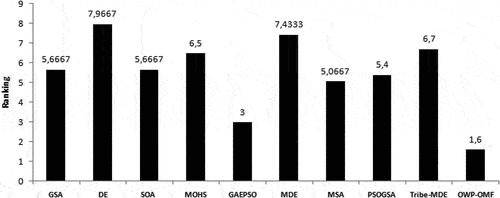
Based on the values mentioned in , the box plot figure was formed and is presented in . From these plots, it is seen that the chances of getting minimum ELD, EMD or CEED is very high as each one of them has lower quartile near to its median from OWP-based OMF.
Table 5. Statistical results obtained over 30 runs with OWP-based OMF for test system 1
Test System II:
This case study consists of ten generation units considering the valve-point effect. The fuel cost coefficients, generators constraint, emission coefficients and transmission loss coefficients matrix are taken from (Basu Citation2011). The generation outputs of the most appropriate solutions for ELD, EMD and CEED problems for 2000 MW load demand are listed in . shows the summarized results that are obtained by OWP-based OMF compared with various optimization algorithms for minimum FC in ELD, minimum E in EMD and minimum TC in CEED.
Table 6. Best achieved solutions for test system II: 10 generators ()
Table 7. Comparison of the minimum FC in ELD, minimum E in EMD, and minimum TC in CEED obtained by difirent algorithms for test system II: 10 generators
Bold entries signify the best results
NR means not reported in the referred literature.
From this table, it can be seen that the proposed algorithm outperforms many algorithms used to solve ELD, EMD and CEED problems because these results are either better or comparable to those obtained using other algorithms. This highlights its ability to find better solutions. From , it is observed that the proposed algorithm gives the better total power loss.
According to the results of the Friedman’s test and Quade’s test shown in respectively, OWP-OMF is ranked the first.
A box plot figure was formed based on the values in and is shown in . From these plots, it’s evident that the OWP-based OMF can produce solutions which always remain closer to the best-obtained value in each trial; the median is smallest for the proposed algorithm.
Table 8. Statistical results obtained over 30 runs with OWP-based OMF for test system 2
Test System III:
This test system consists of forty (40) generating units with non-smooth fuel cost and emission level functions. The input data for the 40-generators test system are taken from (Basu Citation2011), which has a total load of 10,500 MW and no transmission losses are considered. Since this is a larger system with more nonlinear elements, it has more local minima, so it will be more difficult to achieve the global solution. presents the optimum results obtained by OWP-based OMF for ELD, EMD and CEED problems.
Table 9. Best achieved solutions for test system III: 40 generators ()
Bold entries signify the best results
NR means not reported in the referred literature.
The results obtained using the OWP-based OMF are compared to some other algorithms reported in the literature as shown in . From this table, it can be seen that the proposed algorithm provides better results and outperforms many algorithms used to solve ELD, EMD and CEED problems. Except in the case of the fuel cost in CEED minimization, the minimum values of fuel cost, emission and total cost obtained from the proposed OWP-based OMF are lesser in comparison to reported best results in the literature. The result in the case of the CEED minimization obtained by OWP-based OMF can be approximately considered as a result with high cost and low pollution. From , it appears that the proposed algorithm has the competitive performance when comparing other recent optimization algorithms.
Table 10. Comparison of the minimum FC in ELD, minimum E in EMD, and minimum TC in CEED obtained by difirent algorithms for test system III: 40 generators
Also, according to the results of the Friedman’s test and Quade’s test shown in OWP-OMF is ranked the flrst.
Figure 11. Ranking of OWP-OMF and the compared algorithms by the Friedman’s test on test system III.

According to the values mentioned in , a box plot is formed, as shown in . It can be concluded from these figures that the objective function value of each run is nearly close to the best result for each problem; ELD, EMD and CEED problems.
Table 11. Statistical results obtained over 30 runs with OWP-based OMF for test system 3
Conclusion
OWP-based OMF is one of the recent heuristic algorithms presented by ZAOUI and BELMADANI (Zaoui and Belmadani Citation2021) for solving engineering optimization problems. In this paper, OWP-based OMF is successfully applied to solve a combined economic and emission dispatch problem. The proposed algorithm is tested on three different test systems. Here, inequality constraints like valve-point loading, emission, transmission line loss are addressed. The results demonstrate the effectiveness and robustness of the proposed algorithm in solving the CEED problem. In addition, the results of the proposed OWP-based OMF algorithm have been compared to other heuristic algorithms published in the recent literature. The proposed algorithm can provide better solutions than other algorithms. It can be seen from the comparison that the proposed algorithm determines an effective and high-quality solution to the CEED problem.
Disclosure Statement
No potential conflict of interest was reported by the author(s).
Correction Statement
This article has been republished with minor changes. These changes do not impact the academic content of the article.
References
- Abdelaziz, A. Y., E. S. Ali, and S. M. Abd Elazim. 2016. “Combined economic and emission dispatch solution using flower pollination algorithm.” International Journal of Electrical Power & Energy Systems 80:45–66. doi:10.1016/j.ijepes.2015.11.093.
- Abido, M. A. 2003. “Environmental/economic power dispatch using multiobjective evolutionary algorithms.” IEEE Transactions on Power Systems 18 (4):1529–37. doi:10.1109/TPWRS.2003.818693.
- Adarsh, B. R., T. Raghunathan, T. Jayabarathi, and X.-S. Yang. 2016. “Economic dispatch using chaotic bat algorithm.” Energy 96:666–75. doi:10.1016/j.energy.2015.12.096.
- Agarwal, A., and N. Nanavati. 2016. “Association rule mining using hybrid GA-PSO for multi-objective optimisation.” 2016 IEEE International Conference on Computational Intelligence and Computing Research (ICCIC). IEEE, 1–7, Chennai, India.
- Ahmed, T. A., M. Ebeed, A. Refai, and S. Kamel. 2021. “Solving combined economic and emission dispatch problem using the slime mould algorithm.” Sohag Engineering Journal 1 (1):62–70. doi:10.21608/sej.2021.155880.
- Alcala-Fdez, J., L. Sanchez, S. Garcia, M. J. Del Jesus, S. Ventura, J. M. Garrell, J. Otero, C. Romero, J. Bacardit, and V. M. Rivas. 2009. “KEEL: A software tool to assess evolutionary algorithms for data mining problems.” Soft Computing 13 (3):307–18. doi:10.1007/s00500-008-0323-y.
- Aravindhababu, P., and K. R. Nayar. 2002. “Economic dispatch based on optimal lambda using radial basis function network.” International Journal of Electrical Power & Energy Systems 24 (7):551–56. doi:10.1016/S0142-0615(01)00063-1.
- Arunachalam, S., T. AgnesBhomila, and M. Ramesh Babu. 2014. “Hybrid particle swarm optimization algorithm and firefly algorithm based combined economic and emission dispatch including valve point effect.” International Conference on Swarm, Evolutionary, and Memetic Computing. Springer, 647–60, Bhubaneswar, India.
- Basu, M. 2011. “Economic environmental dispatch using multi-objective differential evolution.” Applied Soft Computing 11 (2):2845–53. doi:10.1016/j.asoc.2010.11.014.
- Benasla, L., A. Belmadani, and M. Rahli. 2014. “Spiral optimization algorithm for solving combined economic and emission dispatch.” International Journal of Electrical Power & Energy Systems 62:163–74. doi:10.1016/j.ijepes.2014.04.037.
- Bhattacharjee, K., A. Bhattacharya, and S. Halder nee Dey. 2014. “Solution of economic emission load dispatch problems of power systems by real coded chemical reaction algorithm.” International Journal of Electrical Power & Energy Systems 59:176–87. doi:10.1016/j.ijepes.2014.02.006.
- Bhattacharjee, K., A. Bhattacharya, and S. Halder nee Dey. 2015. “Backtracking search optimization based economic environmental power dispatch problems.” International Journal of Electrical Power & Energy Systems 73:830–42. doi:10.1016/j.ijepes.2015.06.018.
- Bhattacharya, A., and P. K. Chattopadhyay. 2010. “Application of biogeography-based optimization for solving multi-objective economic emission load dispatch problems.” Electric Power Components and Systems 38 (3):340–65. doi:10.1080/15325000903273296.
- Bhongade, S., and S. Agarwal. 2016. “An optimal solution for combined economic and emission dispatch problem using artificial bee colony algorithm.” 2016 Biennial International Conference on Power and Energy Systems: Towards Sustainable Energy (PESTSE),Bengaluru, India.
- Chakrabarti, A., and S. Halder. 2010. Power System Analysis: Operation And Control. 3rd ed. Delhi, India: PHI Learning Pvt. Ltd.
- Chatterjee, A., S. P. Ghoshal, and V. Mukherjee. 2012. “Solution of combined economic and emission dispatch problems of power systems by an opposition-based harmony search algorithm.” International Journal of Electrical Power & Energy Systems 39 (1):9–20. doi:10.1016/j.ijepes.2011.12.004.
- Derrac, J., S. Garcia, D. Molina, and F. Herrera. 2011. “A practical tutorial on the use of nonprametric statistical tests as a methodology for comparing evolutionary and swarm intelligence algorithm.” Swarm and Evolutionary Computation 1 (3):3–18. doi:10.1016/j.swevo.2011.02.002.
- Dey, B., S. Basak, and B. Bhattacharyya. 2021. “A comparative analysis between price-penalty factor method and fractional programming method for combined economic emission dispatch problem using novel hybrid CSA-JAYA algorithm.” IET Smart Grid 4 (4):367–80. doi:10.1049/stg2.12037.
- Dey, B., B. Bhattacharyya, and M. Fausto Pedro García. 2021. “A hybrid optimization-based approach to solve environment constrained economic dispatch problem on microgrid system.” Journal of Cleaner Production 4:5.
- Dey, B., B. Bhattacharyya, A. Srivastava, and K. Shivam. 2020. “Solving energy management of renewable integrated microgrid systems using crow search algorithm.” Soft Computing 24 (14):07. doi:10.1007/s00500-019-04553-8.
- Dey, B., S. Roy, and B. Bhattacharyya. 2018. “Solving multi-objective economic emission dispatch of a renewable integrated microgrid using latest bio-inspired algorithms.” Engineering Science and Technology, an International Journal 22:10.
- Dodu, J. C., P. Martin, A. Merlin, and J. Pouget. 1972. “An optimal formulation and solution of short-range operating problems for a power system with flow constraints.” Proceedings of the IEEE 60 (1):54–63. doi:10.1109/PROC.1972.8557.
- El-Keib, A. A., H. Ma, and J. L. Hart. 1994. “Environmentally constrained economic dispatch using the Lagrangian relaxation method.” IEEE Transactions on Power Systems 9 (4):1723–29. doi:10.1109/59.331423.
- Elsayed, W. T., and E. F. El-Saadany. 2015. “A fully decentralized approach for solving the economic dispatch problem.” IEEE Transactions on Power Systems 30 (4):2179–89. doi:10.1109/TPWRS.2014.2360369.
- Elsayed, W. T., Y. G. Hegazy, F. M. Bendary, and M. S. El-Bages. 2016. “Modified social spider algorithm for solving the economic dispatch problem.” Engineering Science and Technology, an International Journal 19 (4):1672–81. doi:10.1016/j.jestch.2016.09.002.
- Gherbi, Y. A., H. Bouzeboudja, and F. Z. Gherbi. 2016. “The combined economic environmental dispatch using new hybrid metaheuristic.” Energy 115:468–77. doi:10.1016/j.energy.2016.08.079.
- Gong, D.-W., Y. Zhang, and C.-L. Qi. 2010. “Environmental/economic power dispatch using a hybrid multi-objective optimization algorithm.” International Journal of Electrical Power & Energy Systems 32 (6):607–14. doi:10.1016/j.ijepes.2009.11.017.
- Guesmi, T., A. Farah, I. Marouani, B. Alshammari, and H. H. Abdallah. 2020. “Chaotic sine–cosine algorithm for chance-constrained economic emission dispatch problem including wind energy.” IET Renewable Power Generation 14 (10):1808–21. doi:10.1049/iet-rpg.2019.1081.
- Hamid, B., A. Chaker, A. Ahmed, and B. Naama. 2005. “Economic dispatch solution using a real-coded genetic algorithm.” 5:01.
- Jevtic, M., N. Jovanovic, J. Radosavljevic, and D. Klimenta. 2017. “Moth swarm algorithm for solving combined economic and emission dispatch problem.” Elektronika Ir Elektrotechnika 23 (5):21–28. doi:10.5755/j01.eie.23.5.19267.
- Jiang, S., Ji, Z. Ji, and Y. Wang. 2015b. “A novel gravitational acceleration enhanced particle swarm optimization algorithm for wind–thermal economic emission dispatch problem considering wind power availability.” International Journal of Electrical Power & Energy Systems 73:1035–50.
- Jiang, S., Z. Ji, and Y. Wang. 2015a. “A novel gravitational acceleration enhanced particle swarm optimization algorithm for wind–thermal economic emission dispatch problem considering wind power availability.” International Journal of Electrical Power & Energy Systems 73:1035–50. doi:10.1016/j.ijepes.2015.06.014.
- Kheshti, M., X. Kang, J. Li, P. Regulski, and V. Terzija. 2018. “Lightning flash algorithm for solving non-convex combined emission economic dispatch with generator constraints.” IET Generation, Transmission & Distribution 12 (1):104–16. doi:10.1049/iet-gtd.2017.0257.
- Kuk, J. N., R. A. Gonçalves, L. M. Pavelski, S. M. Guse Scós Venske, C. P. Almeida, and A. T. Ramirez Pozo. 2021. “An empirical analysis of constraint handling on evolutionary multi-objective algorithms for the environmental/economic load dispatch problem.” Expert Systems with Applications 165:113774. doi:10.1016/j.eswa.2020.113774.
- Meng, K., H. G. Wang, Z. Dong, and K. P. Wong. 2010. “Quantum-inspired particle swarm optimization for valve-point economic load dispatch.” IEEE Transactions on Power Systems 25 (1):215–22. doi:10.1109/TPWRS.2009.2030359.
- Morsali, R., M. Mohammadi, I. Maleksaeedi, and N. Ghadimi. 2014. “A new multiobjective procedure for solving nonconvex environmental/economic power dispatch.” Complexity 20 (2):47–62. doi:10.1002/cplx.21505.
- Nanda, J. 1994. “Economic emission load dispatch with line flow constraints using a classical technique.” IEE Proceedings - Generation, Transmission and Distribution 141 (1):1–10. doi:10.1049/ip-gtd:19949770.
- Niknam, T., H. D. Mojarrad, and B. B. Firouzi. 2013. “A new optimization algorithm for multi-objective economic/emission dispatch.” International Journal of Electrical Power & Energy Systems 46:283–93. doi:10.1016/j.ijepes.2012.10.001.
- Palit, D., and N. Chakraborty. 2019. “Optimal bidding in emission constrained economic dispatch.” International Journal of Environmental Science and Technology 16 (12):7953–72. doi:10.1007/s13762-018-2160-6.
- Parikh, J., and D. Chattopadhyay. 1996. “A multi-area linear programming approach for analysis of economic operation of the Indian power system.” IEEE Transactions on Power Systems 11 (1):52–58. doi:10.1109/59.485985.
- Pazheri, F. R., M. F. Othman, N. H. Malik, and Y. Khan. 2015. “Emission constrained economic dispatch for hybrid energy system in the presence of distributed generation and energy storage.” Journal of Renewable and Sustainable Energy 7 (1):013125. doi:10.1063/1.4906930.
- Postaire, J.-G., and C. Vasseur. 1981. “An approximate solution to normal mixture identification with application to unsupervised pattern classification.” IEEE Transactions on Pattern Analysis and Machine Intelligence PAMI-3 (2):163–79. doi:10.1109/TPAMI.1981.4767074.
- Radosavljević, J. 2016. “A solution to the combined economic and emission dispatch using hybrid PSOGSA algorithm.” Applied Artificial Intelligence 30 (5):445–74. doi:10.1080/08839514.2016.1185860.
- Rex, C. R., M. B. Edwin, and J. Annrose. 2019. “A solution for combined economic and emission dispatch problem using hybrid optimization techniques.” Journal of Electrical Engineering & Technology 09. doi:10.1007/s42835-019-00192-z
- Rex, C. R. E. S., and M. Marsaline Beno. 2017. “State of art in combined economic and emission dispatch.” Middle-East J. Sci. Res 25:56–64.
- Roy, P. K., and S. Bhui. 2013. “Multi-objective quasi-oppositional teaching learning based optimization for economic emission load dispatch problem.” International Journal of Electrical Power & Energy Systems 53:937–48. doi:10.1016/j.ijepes.2013.06.015.
- Senthil, K., and K. Manikandan. 2010. “Economic thermal power dispatch with emission constraint and valve point effect loading using improved tabu search algorithm.” International Journal of Computer Applications 3 (9):6–11. doi:10.5120/770-1080.
- Sivasubramani, S., and K. S. Swarup. 2011. “Environmental/economic dispatch using multi-objective harmony search algorithm.” Electric Power Systems Research 81 (9):1778–85. doi:10.1016/j.epsr.2011.04.007.
- Srivastava, A., and D. K. Das. 2020. “A new Kho-Kho optimization Algorithm: An application to solve combined emission economic dispatch and combined heat and power economic dispatch problem.” Engineering Applications of Artificial Intelligence 94:103763. doi:10.1016/j.engappai.2020.103763.
- Subathra, M. S. P., S. Easter Selvan, T. Aruldoss Albert Victoire, A. Hepzibah Christinal, and U. Amato. 2015. “A hybrid with cross-entropy method and sequential quadratic programming to solve economic load dispatch problem.” IEEE Systems Journal 9 (3):1031–44. doi:10.1109/JSYST.2013.2297471.
- Sundaram, A. 2020. “Multiobjective multi-verse optimization algorithm to solve combined economic, heat and power emission dispatch problems.” Applied Soft Computing 91:106195. doi:10.1016/j.asoc.2020.106195.
- Sundaram, A., and P. Erdogmus. 2017. Particle Swarm Optimization with Applications, Pakize Erdoğmuş, IntechOpen. doi:10.5772/intechopen.72807. Available from: https://www.intechopen.com/chapters/58629
- Sundaram, A., R. Saranya, and N. Sangeetha. 2013. International conference on swarm, evolutionary, and memetic computing. Springer.
- Walters, D. C., and G. B. Sheble. 1993. “Genetic algorithm solution of economic dispatch with valve point loading.” IEEE Transactions on Power Systems 8 (3):1325–32. doi:10.1109/59.260861.
- Wong, K. P., and C. C. Fung. 1993. “Simulated annealing based economic dispatch algorithm.” IEE Proceedings C Generation, Transmission and Distribution 140 (6):509–15. doi:10.1049/ip-c.1993.0074.
- Wood, A. J., B. F. Wollenberg, and G. B. Sheblé. 1996. Power generation, operation, and control. New York: John Wiley & Sons.
- Zaoui, S., and A. Belmadani. 2021. “Solving engineering optimization problems without penalty.” International Journal of Computational Methods 18 (4):2150007. doi:10.1142/S0219876221500079.

